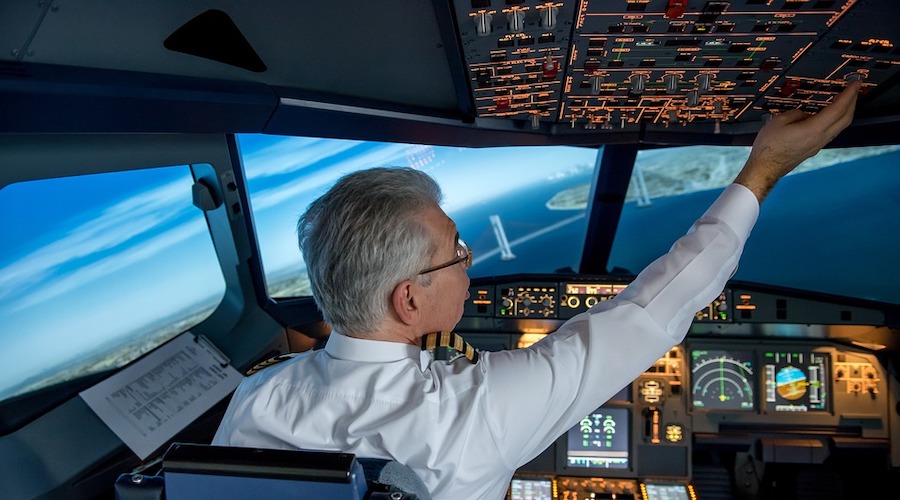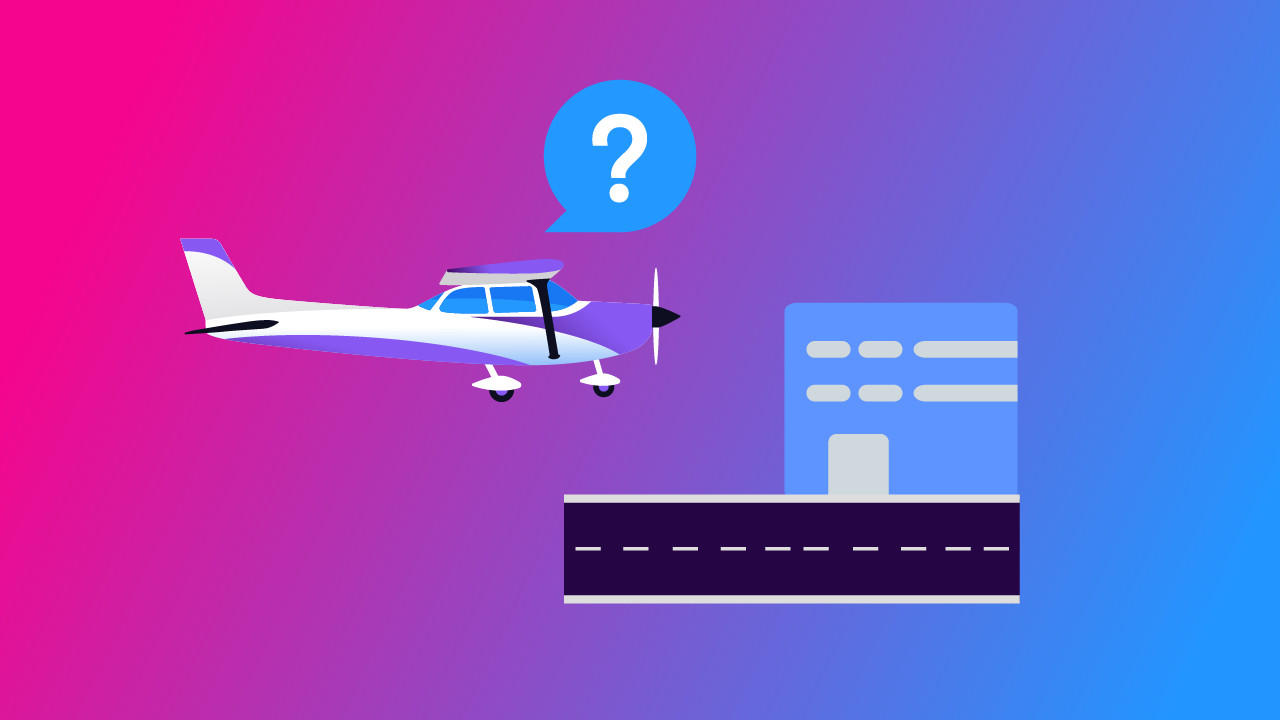Compared to a few decades ago, air travel is a lot more in demand nowadays. A major factor behind this trend is the much lower cost of commercial flights. There’s also the fact that the Internet has made information exchange so much easier, making traveling to foreign lands less intimidating than it used to be.
While there will always be enough planes to keep up with the demands of commercial air travel, there’s a crucial question that we need to ask: are there enough pilots? And will there still be enough pilots several years from now to keep up with the increasing demands?
The age distribution of licensed pilots in 2021
To evaluate how healthy the population of licensed pilots are today, let’s look at the age distribution of both student and for-hire pilots. The data, as provided by the FAA, with a bit of our analysis, are summarized below:
| Age Group | Total | Student | Sport | Recreational | Private | Commercial | Airline Transport | CFI | %TOTAL |
| Total | 720,603 | 250,197 | 6,801 | 86 | 173,606 | 119,827 | 170,086 | 121,270 | |
| 14-15 | 552 | 552 | 0 | 0 | 0 | 0 | 0 | 0 | 0.08 |
| 16-19 | 24,568 | 18,615 | 10 | 1 | 5,613 | 329 | 0 | 117 | 3.41 |
| 20-24 | 75,925 | 41,178 | 82 | 3 | 19,161 | 14,481 | 1,020 | 7,264 | 10.54 |
| 25-29 | 89,307 | 49,116 | 152 | 4 | 14,152 | 19,366 | 6,517 | 11,828 | 12.39 |
| 30-34 | 76,933 | 39,706 | 254 | 6 | 13,230 | 12,923 | 10,814 | 12,264 | 10.68 |
| 35-39 | 69,460 | 28,513 | 314 | 3 | 13,102 | 10,667 | 16,861 | 13,933 | 9.64 |
| 40-44 | 60,499 | 20,740 | 319 | 1 | 12,217 | 8,262 | 18,960 | 12,772 | 8.40 |
| 45-49 | 50,597 | 13,375 | 373 | 6 | 10,703 | 6,493 | 19,647 | 11,184 | 7.02 |
| 50-54 | 56,118 | 11,754 | 520 | 5 | 13,181 | 7,357 | 23,301 | 11,664 | 7.79 |
| 55-59 | 59,212 | 9,753 | 799 | 5 | 15,512 | 7,829 | 25,314 | 10,639 | 8.22 |
| 60-64 | 56,972 | 7,335 | 1,050 | 13 | 17,927 | 8,096 | 22,551 | 9,328 | 7.91 |
| 65-69 | 43,117 | 4,802 | 1,091 | 19 | 16,941 | 8,082 | 12,182 | 7,928 | 5.98 |
| 70-74 | 28,915 | 2,862 | 883 | 13 | 11,814 | 6,904 | 6,439 | 6,109 | 4.01 |
| 75-79 | 17,718 | 1,314 | 578 | 4 | 6,567 | 5,259 | 3,996 | 3,999 | 2.46 |
| 80 and over | 10,710 | 582 | 376 | 3 | 3,486 | 3,779 | 2,484 | 2,241 | 1.49 |
To make sense of all these numbers, let’s discuss the important points separately:
- The total number of pilots includes both student pilots and for-hire pilots. From the tally of student pilots, it’s easy to see that most of them are on the younger side – around 21% belong to the 20 to 29 age group, and around 18% are aged 30 to 39. This isn’t surprising as most pilots get their training at a young age. The high numbers may also provide a false assurance, as it’s pretty much a given that not all these students will develop into for-hire pilots.
- To give us a more realistic perspective of the status of the current pilot population, we must look at the total number of for-hire pilots. The shift is massive. Based on the data, more than 30% of the current for-hire pilots fall within the age range of 50 to 64. In 2009, the US Congress changed the mandatory age of retirement of airline pilots from 60 to 65 in a bid to solve the pilot shortage problem. This means that around 30% of the for-hire pilots we have right now will have to retire within the next 15 years.
- The facts become even more sobering when you take the total number of for-hire pilots in the 50 to 64 age group. The total is about 150,000 pilots. Let’s suppose that we live in an ideal world where all student pilots convert into for-hire pilots after they finish the training and certification process. To make up for the population of pilots who will retire in the next 15 years, we will need all student pilots in the whole age range of 16 to 54 to become for-hire pilots. To compare further, the number of student pilots within the age range of 20 to 39 is only around 113,000.
What can we say based on the current numbers? Well, the situation isn’t looking good. More than a hundred thousand pilots will have to retire in the next ten years, and we simply don’t have enough student pilots to make up for the hole that they will leave.
Historical trends of the average age of licensed pilots
Let’s dig deeper into the problem and look at the historical trends of age group distribution among licensed pilots. The results of our analysis of the data available from the FAA are summarized below:
| Age Group | 2017 | 2018 | 2019 | 2020 | 2021 | |||||
| TOTAL | % of TOTAL | TOTAL | % of TOTAL | TOTAL | % of TOTAL | TOTAL | % of TOTAL | TOTAL | % of TOTAL | |
| Total | 609,305 | 633,316 | 664,563 | 691,689 | 720,603 | |||||
| 14-15 | 317 | 0.05 | 294 | 0.05 | 465 | 0.07 | 561 | 0.08 | 552 | 0.08 |
| 16-19 | 17,350 | 2.74 | 16,932 | 2.67 | 21,229 | 3.19 | 23,288 | 3.37 | 24,568 | 3.41 |
| 20-24 | 61,034 | 9.64 | 63,652 | 10.05 | 70,041 | 10.54 | 72,979 | 10.55 | 75,925 | 10.54 |
| 25-29 | 67,091 | 10.72 | 72,472 | 11.44 | 78,366 | 11.79 | 84,166 | 12.17 | 89,307 | 12.39 |
| 30-34 | 57,885 | 9.14 | 61,368 | 9.69 | 66,742 | 10.04 | 71,896 | 10.39 | 76,933 | 10.68 |
| 35-39 | 53,294 | 8.42 | 57,068 | 9.01 | 61,715 | 9.29 | 65,123 | 9.42 | 69,460 | 9.64 |
| 40-44 | 46,771 | 7.39 | 48,850 | 7.71 | 52,044 | 7.83 | 56,103 | 8.11 | 60,499 | 8.40 |
| 45-49 | 49,362 | 7.79 | 49,234 | 7.77 | 49,602 | 7.46 | 49,029 | 7.09 | 50,597 | 7.02 |
| 50-54 | 55,746 | 8.80 | 55,024 | 8.69 | 54,642 | 8.22 | 55,326 | 8.00 | 56,118 | 7.79 |
| 55-59 | 59,930 | 9.46 | 60,473 | 9.54 | 60,477 | 9.10 | 59,746 | 8.64 | 59,212 | 8.22 |
| 60-64 | 54,309 | 8.58 | 55,947 | 8.83 | 55,915 | 8.41 | 56,318 | 8.14 | 56,972 | 7.91 |
| 65-69 | 37,879 | 5.98 | 39,805 | 6.29 | 40,269 | 6.06 | 41,732 | 6.03 | 43,117 | 5.98 |
| 70-74 | 26,444 | 4.18 | 28,083 | 4.43 | 28,125 | 4.23 | 28,758 | 4.16 | 28,915 | 4.01 |
| 75-79 | 12,967 | 2.05 | 14,961 | 2.36 | 15,628 | 2.35 | 16,537 | 2.39 | 17,718 | 2.46 |
| 80 and over | 8,116 | 1.28 | 9,188 | 1.45 | 9,303 | 1.40 | 10,127 | 1.46 | 10,710 | 1.49 |
First, let’s look at the trend of the number of licensed pilots from 2014 to 2018, including the student pilots. After a period of steady decrease, the total number of licensed pilots have picked up in 2017 and 2018. This certainly seems encouraging, especially considering that the 25 to 39 age groups seem to be driving this increase. As of 2018, the 25 to 39 age group comprises the majority of the population of licensed pilots.
Looking at the older age groups gives us cause for concern. Over the last five years, we can observe a migration of numbers from the 40 to 59 age groups to the 60 and above age groups. This is natural, of course, and serves to demonstrate how many of these licensed pilots are entering the retirement age.
However, as we’ve discussed earlier, not all of the student pilots will successfully become licensed pilots. Some of them drop out during training, cannot complete the required number of flight hours, or do not pass the certification test. To eliminate the bloating effect of the number of student pilots, let’s look at the age group population of only the for-hire pilots.
A few interesting observations can be made from the trends:
- Despite an apparent increase in licensed drone pilots from 2016 to 2018, the number of for-hire pilots has not recovered from the slump between 2014 to 2016. As of 2018, there is still a smaller number of for-hire pilots than there was in 2014. This means that a lot of the licensed drone pilots recorded in 2017 and 2018 are students, and they may not necessarily make the transition to being for-hire pilots.
- The percentage of for-hire pilots that belong to the 20 to 39 age groups has remained fairly stagnant in the last five years, indicating a slow intake of new for-hire pilots. In contrast, the number of fore-hire pilots in the 40 to 59 age group has dropped by a huge margin since 2014 because of aging, making the transition to the older age groups.
- Even more troubling is the fact that the fastest population increase has been observed in the 70 and above age group. These pilots are effectively already retired.
- The percentage of for-hire pilots belonging to age groups 50 and above have remained in the 49% to 52% range for the last five years. This is a figure we expect to increase as these pilots continue to grow older.
From the numbers, it’s quite clear that the aviation industry is facing the problem of an aging population of licensed and for-hire pilots. With about 50% of for-hire pilots retiring in the next 20 years, will there be enough trainees to take their place?
Are we facing a shortage of licensed pilots?
An aging population of for-hire pilots isn’t the only problem that the aviation industry has to deal with. With a host of socio-economic and regulatory issues in the mix, the possibility of a pilot shortage appears to be even worse than we expected.
The increase in demand for commercial and private flights continues year by year. Boeing estimates that 790,000 new pilots will be needed globally by 2037. Airbus has a slightly more conservative but still overwhelming forecast of 450,000 new pilots needed by 2035.
The increasing demand is an issue on a global scale, with the Asia Pacific region alone needing 261,000 new pilots in the next 20 years. The North America region isn’t going to fare much better, with a need for 206,000 new pilots by 2037.
Another factor exacerbating the problem is the number of flight hours needed to earn a commercial pilot license. The new regulation, requiring a total of 1500 accumulated hours, was borne out of the Colgan Air 3407 crash back in 2009. In 2010, the US Congress changed duty-time rules for pilots to reduce fatigue, which means that commercial airlines will need more pilots on staff than before.
Aviation experts have called this combination of factors a “perfect storm” that will bring about a massive pilot shortage in the next couple of years. Still, the biggest enemy is time, as it seems that there are not enough trainees to both replace the population of retiring pilots and to meet the increasing demand for commercial and private pilots.
What is being done to avoid this shortage?
Addressing the problem of a future pilot shortage requires a multi-pronged approach by both the aviation industry and the legislators. Still, there is only one ultimate goal: to train enough pilots to meet future demands. Here are the efforts being made to solve the pilot shortage problem, sustainably or otherwise:
- There have been talks of extending the retirement age for commercial pilots to 67. This is NOT a long-term solution and will only serve to delay the onset of the pilot shortage. What it provides is more time for the powers-that-be to come up with a more viable and sustainable solution.
- The US Senate has made minor amendments to the 1500-hour rule, allowing pilots to earn their commercial license with less than 1500 accumulated flight hours if they do their training in selected flight schools.
- Airlines are considering dropping the requirement to have finished a four-year degree course to apply for a commercial pilot position. Having a degree, after all, does not reflect on the competency of a pilot to fly an aircraft. This is a cultural shift that could open the doors to more young Americans pursuing a career in aviation.
- Commercial airlines are creating their own pipelines of new licensed pilots by crafting training programs with guaranteed positions for successful trainees. An example is the American Airlines Cadet Academy, which was established to train their own pilot candidates.
- Airlines are now offering higher pay and signing bonuses for pilots in the hopes of making a career in aviation more appealing for potential students.
- AI-enabled flight may make it possible for flights to be undertaken by just a single pilot, effectively cutting the demand for pilots by half. However, this technology is still far from being developed and tested. We’ll probably have to wait more than a decade for this to become a reality.
- There is a large population that is yet to be tapped for training as pilots – women. As of the end of 2018, only about 6% of for-hire pilots are women. Encouraging women to be pilots may just be the push that the industry needs to spark rapid growth in the number of licensed pilots. However, female representation can only be promoted if the industry can overcome deep-seated gender stereotypes. This could take a lot of work but will certainly benefit the aviation industry in more ways than one.
None of these measures provide a definite solution to the problem. Some of them are still ideas yet to be implemented. What is apparent is that it will require a combination of changes in policy, compensation, competencies, and culture to avoid the potential pilot shortage.
Final thoughts
It’s quite clear from the trends that the pool of licensed pilots is growing older. With 50% of the current licensed pilots retiring in the next 20 years, the aviation industry needs to step up their efforts on recruiting trainees as replacements. The fact that the demand for commercial and private flight continues to grow also doesn’t help.
To answer our original question – yes, we are facing a pilot shortage. If nothing changes, this shortage will certainly have palpable effects in the next 10 to 15 years.




